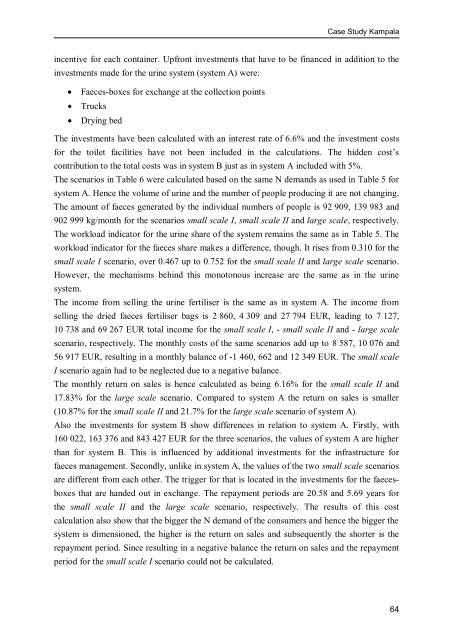Economic Effects of Sustainable Sanitation - SuSanA
Economic Effects of Sustainable Sanitation - SuSanA
Economic Effects of Sustainable Sanitation - SuSanA
You also want an ePaper? Increase the reach of your titles
YUMPU automatically turns print PDFs into web optimized ePapers that Google loves.
Case Study Kampala<br />
incentive for each container. Upfront investments that have to be financed in addition to the<br />
investments made for the urine system (system A) were:<br />
Faeces-boxes for exchange at the collection points<br />
Trucks<br />
Drying bed<br />
The investments have been calculated with an interest rate <strong>of</strong> 6.6% and the investment costs<br />
for the toilet facilities have not been included in the calculations. The hidden cost‘s<br />
contribution to the total costs was in system B just as in system A included with 5%.<br />
The scenarios in Table 6 were calculated based on the same N demands as used in Table 5 for<br />
system A. Hence the volume <strong>of</strong> urine and the number <strong>of</strong> people producing it are not changing.<br />
The amount <strong>of</strong> faeces generated by the individual numbers <strong>of</strong> people is 92 909, 139 983 and<br />
902 999 kg/month for the scenarios small scale I, small scale II and large scale, respectively.<br />
The workload indicator for the urine share <strong>of</strong> the system remains the same as in Table 5. The<br />
workload indicator for the faeces share makes a difference, though. It rises from 0.310 for the<br />
small scale I scenario, over 0.467 up to 0.752 for the small scale II and large scale scenario.<br />
However, the mechanisms behind this monotonous increase are the same as in the urine<br />
system.<br />
The income from selling the urine fertiliser is the same as in system A. The income from<br />
selling the dried faeces fertiliser bags is 2 860, 4 309 and 27 794 EUR, leading to 7 127,<br />
10,738 and 69 267 EUR total income for the small scale I, - small scale II and - large scale<br />
scenario, respectively. The monthly costs <strong>of</strong> the same scenarios add up to 8 587, 10 076 and<br />
56 917 EUR, resulting in a monthly balance <strong>of</strong> -1 460, 662 and 12 349 EUR. The small scale<br />
I scenario again had to be neglected due to a negative balance.<br />
The monthly return on sales is hence calculated as being 6.16% for the small scale II and<br />
17.83% for the large scale scenario. Compared to system A the return on sales is smaller<br />
(10.87% for the small scale II and 21.7% for the large scale scenario <strong>of</strong> system A).<br />
Also the investments for system B show differences in relation to system A. Firstly, with<br />
160.022, 163 376 and 843 427 EUR for the three scenarios, the values <strong>of</strong> system A are higher<br />
than for system B. This is influenced by additional investments for the infrastructure for<br />
faeces management. Secondly, unlike in system A, the values <strong>of</strong> the two small scale scenarios<br />
are different from each other. The trigger for that is located in the investments for the faeces-<br />
boxes that are handed out in exchange. The repayment periods are 20.58 and 5.69 years for<br />
the small scale II and the large scale scenario, respectively. The results <strong>of</strong> this cost<br />
calculation also show that the bigger the N demand <strong>of</strong> the consumers and hence the bigger the<br />
system is dimensioned, the higher is the return on sales and subsequently the shorter is the<br />
repayment period. Since resulting in a negative balance the return on sales and the repayment<br />
period for the small scale I scenario could not be calculated.<br />
64

















